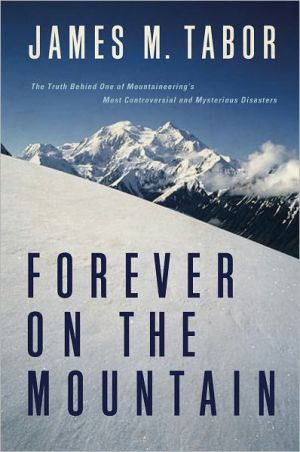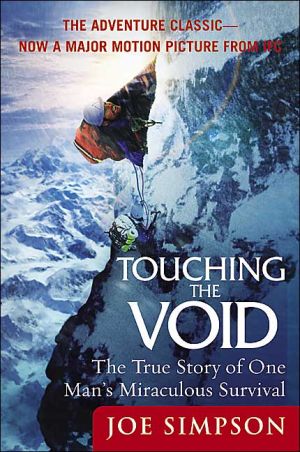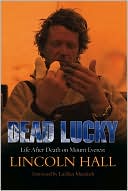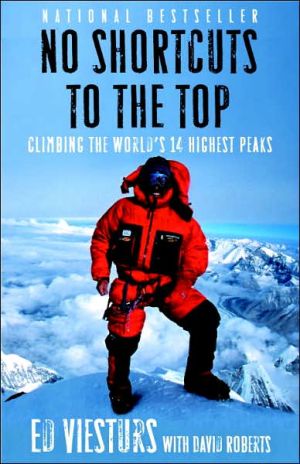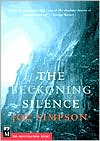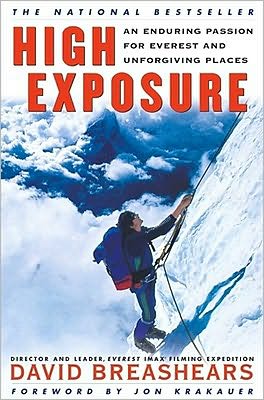Forever on the Mountain: The Truth Behind One of the Most Tragic, Mysterious, and Controversial Disasters in Mountaineering History
Ten days passed with no rescue attempt, while more than half an expedition was stranded and dying at 20,000 feet during a vicious Arctic storm. The bodies were never recovered. And, for reasons that have remained cloudy, there was no proper official investigation of the catastrophe.\ This book begins as a classic tale of men against nature, gambling—and losing—on one of the world's starkest and stormiest peaks. Reckoning by lives lost, it was history's third-worst mountaineering disaster when...
Search in google:
In July 1967, seven young men—members of Joe Wilcox's twelve-man expedition—died on Mt. McKinley, North America's highest peak.Ten days passed with no rescue attempt, while more than half an expedition was stranded and dying at 20,000 feet during a vicious Arctic storm. The bodies were never recovered. And, for reasons that have remained cloudy, there was no proper official investigation of the catastrophe.This book begins as a classic tale of men against nature, gambling—and losing—on one of the world's starkest and stormiest peaks. Reckoning by lives lost, it was history's third-worst mountaineering disaster when it occurred—but elements of finger pointing, incompetence, and cover-up make this disaster unlike any other. James M. Tabor draws on previously untapped sources: personal interviews with survivors and those involved in the aftermath, unpublished diaries and letters, and government documents. He consults not only mountaineers but also experts in disciplines including meteorology, forensics, and psychology. What results is the first full account of the tragedy that ended a golden age in mountaineering. Maps; 8 pages of illustrations. Publishers Weekly Tabor's exhaustive look at the doomed 1967 expedition to scale Alaska's Mt. McKinley is an often gripping, detailed account of the infamous climb that remains controversial. Only five of the 12-man team survived the ascent to the 20,320-foot summit, making it one of the deadliest mountaineering disasters in North America. The journey was fraught with tension from the beginning: the National Park Service (NPS) required a group of nine men, led by Joe Wilcox, to merge with a three-member party of Coloradoans, led by Howard Snyder. Wilcox and Snyder clashed almost immediately. Both men survived and went on to retell the trip in books: Snyder in his 1973 version that mostly blamed Wilcox's leadership; Wilcox's account in 1981 cited an overpowering storm as the culprit in the deaths. Tabor (who hosted PBS's Great Outdoors) shows that the NPS was very slow to react and might have saved the climbers with quicker response. His writing about the brutal difficulties of climbing Mt. McKinley in subfreezing temperatures with hurricane-like wind in blizzard conditions is breathtaking, although he lapses into minutiae and repeats details, particularly regarding the accident's investigation. His profiles of the expedition's survivors 40 years later make for a strong conclusion to the book. (July)Copyright 2007 Reed Business Information
Prologue\ Sharp End of the Dream \ \ It is 3:00 p.m. on Monday, July 17, 1967. In Camp VII at 17,900 feet, six members of the Joseph Wilcox Mount McKinley Expedition are making final preparations for their attempt on the mountain's summit—2,420 vertical feet higher and two miles distant. They are expedition deputy leader Jerry Clark and climbers Hank Janes, Dennis Luchterhand, Mark McLaughlin, John Russell, and Walt Taylor. A seventh man, Steve Taylor (unrelated to Walt), is suffering from altitude and will stay in his tent while the others climb. \ \ They all have endured the agonies of hell for this one shot at McKinley's summit, but they take plenty of time to make sure that Steve has everything he will need while they're gone. Many climbers would be shattered by failing to reach the top after having invested so much money, time, and pain to reach that one small white spot, no bigger than a tabletop, at 20,320 feet. But Steve is a gentle, playful twenty-two year old, and a devout Mormon, and that helps him accept fate with grace unusual in one so young.\ \ Their bodies, journals, and cameras are still somewhere on McKinley, but before the expedition they wrote autobiographies and many letters. After it people who knew them well wrote many things about them, and the expedition's five other men remember them well. In addition, all expeditions making ready for their summit bids go through similar rituals, so I can see them piling more snow around Steve's orange tent, giving him an extra sleeping pad, chocolate, Logan bread. Tall Mark McLaughlin, team jester, may toss in an extra roll of toilet paper—because you're so full of it! Hank Janes, the small, quiet teacher who has turned out to be utterly capable up here, might melt extra snow for Steve's water. \ \ Their leader, now that Joe Wilcox and four others have descended to a lower camp, is freckle-faced Jerry Clark, thirty-one, a good man to be with on a bad mountain: affable, unflappable, quick to smile and slow to snap. It's rare to find him not grinning about something, but just now it bothers him that National Park Service rangers down below have provided no weather forecast. He has spent years in high mountains as far away as Antarctica and can read signs such as backing wind and puffy altocumulus clouds clustering up like fat boys at a dance, and, especially, thin, high cirrus clouds that look like white scratches in the polished blue sky. The signs he can't see are the ones that concern him. \ \ It's not idle worry, because McKinley is like no other place on Earth, and Jerry knows it. The highest point in North America, McKinley is 2,400 miles and 35 degrees of latitude farther north than Everest, which one expert calls "tropical" by comparison. Earth's atmosphere is thickest near the equator and grows thinner nearing the poles; McKinley's proximity to the North Pole makes its 20,320-foot altitude equal to 23,000 feet or more in the Himalaya. Finally, this mountain is not far from the Bering Sea, which sends monstrous storms whirling east with frightening regularity. McKinley, due east, is like a rock sticking up into a river's violent whitewater. \ \ Jerry understands all this. He knows, too, that McKinley is one of those mountains big enough to brew up its own bad weather, which can go from blue sky to wild blizzard in an hour or less, bringing storms such as the white squalls that kill big ships on the open ocean. \ \ By now the men have had three hours of clear sky, stable temperatures, and light winds, and Jerry knows that on a mountain like this there are no guarantees—hopes, probabilities, possibilities, but never guarantees. So at some point, after all the signs are read and permutations calculated, you have to commit and go. It's like the V1 takeoff "point of no return" for aircraft—once you reach that speed, stopping is no longer an option. You just have to aim for the sky and have faith. \ \ Jerry takes one final look at the men in their puffy parkas the colors of autumn leaves. Making up the first rope are handsome, indefatigable Walt Taylor, strongman John Russell, and fireplug Hank Janes. Jerry Clark, lanky Dennis Luchterhand, and good-humored, steady Mark McLaughlin are the second rope. At about half past three, Jerry shouts something like, \ \ Hey, you mothahs—we gung ho and good to go? \ \ They shout back, but one man at least is not feeling so gung ho. Two days before, John Russell, the expedition's Incredible Hulk, gave out suddenly, astonishing himself as much as his rope mates, on the grueling carry from Camp VI, at 15,000 feet, to Camp VII, at 17,900 feet. The next day was a storm day, which allowed him some rest. He feels better today than when he crept into camp so sick he could barely see after that horrible haul. But he does not feel good, and it is the first time in his life that John's iron-muscled body has betrayed him. \ \ One of the hard lessons they've all learned during this, their first excursion above 14,000 feet, is that altitude sucks. Literally. It sucks energy from muscles and thoughts from brains and joy clean out of dreams. If you're a woman with children, imagine your worst hangover on top of first-trimester morning sickness combined with the flu. If you're a male, combine the hangover and flu with running sprints. \ \ Altitude is not only debilitating—it's fickle beyond imagining. Every human reacts differently, so the hundreds of training miles you ran, those endless sickening wind sprints, the fast hikes under hundred-pound packs may count for absolutely nothing up high. During the first ascent of Mount McKinley in 1913, the party leader, Archdeacon Hudson Stuck, suffered cruelly from altitude and saw how differently others on his team responded: "Karstens, who smoked continually, and Walter, who had never smoked in his life, had the best wind of the party." Up here all suffer, a few thrive, and some just sit down and die, as did a climber on June 29, 2006, while descending the Headwall of the West Buttress route at about 15,500 feet. At 5:30 p.m., the man simply sat down and never stood up again, despite teammates' frantic CPR and rescue efforts. \ \ Thus stocky Walt Taylor, the twenty-four-year-old wunderkind enrolled in an elite MD/MA program, has never been above 14,000 feet but is the strongest of them all up here. Face painted clownlike with white zinc oxide, head crowned with his orange wool fez, he has the lead spot on the first rope. That's like being an infantry squad's point man, working harder, taking the big risks: first to fall in a crevasse, first to be eaten by an avalanche, first to crack a cornice and take a 7,000-foot plunge. \ \ Walt is perfect for point work—muscular and tough and with the genetic blessing of acclimatizing well. He's also funny, in a wry Indiana way, and humor is a huge help on an expedition, especially in somebody leading the pack. In the autobiography he wrote as part of his climbing permit application, Walt stated: "I was born in Indiana, went to high school in Indiana, attended college in Indiana, have a burial plot reserved in Indiana, but I plan to die elsewhere." About a month before the expedition, he also wrote this in a letter to his good friend Jerry: "Perhaps our party is a lot weaker than I've guessed." \ \ Back in camp, Steve Taylor stands alone watching his friends climb the easy slope to Denali Pass. Steve started this expedition at 150 pounds. By this, the twenty-ninth day, he's lost more than fifteen pounds, so his red parka and pants are hanging on his bony, six-feet-two frame. His scraggly beard and weather-battered face make him look ten years older. \ \ Jerry Clark is not the kind of man—none of them are—who will abandon a sick companion high up, summit or no summit, if he thinks doing so will endanger him. But Steve is eating and drinking, urinating and defecating, making sense when he talks, and staying upright when he walks. His lungs are clear, and his brain, though fogged like all the others', is still ticking over. He has enough food and fuel to sustain him here for days, and the weather looks stable. So he urged the others on, knowing how much they have sacrificed for this, and he is genuinely happy as he watches them climb right to left across the silver arc of Denali Pass, heading toward the black rocks at its southern end, their silhouettes, a half mile distant, etched into the cobalt sky as they climb to the sharp end of their dream.
\ From Barnes & NobleBarnes & Noble Discover Great New Writers\ In the summer of 1967, 12 young Americans set out to test their mettle against the elements on an expedition up North America's highest peak, Mount McKinley. Only five returned. In the simplest of terms, the raw force of nature set upon the climbing party. A perfect arctic storm descended and pummeled them for days. The seven members of the party stranded at the highest camp, some 20,000 feet above sea level, were lost forever, their bodies never recovered. \ \ At the time, most climbing experts and government officials were content to lay blame for the tragedy at the feet of Joe Wilcox, the leader of the ill-fated expedition. Joe was a brash, cocky climber, who famously locked horns with climbing legend Bradford Washburn in the months just prior to the climb. Hubris was an easy explanation that conveniently deflected a more probing inquiry into the cause of the disaster and left unanswered the question as to why it took ten days before a rescue effort was mounted. \ \ In the tradition of Norman McClean's Young Men and Fire, in Forever on the Mountain, Tabor delves into the mystery of one of America's most controversial climbing disasters and yields a white-knuckle narrative as well as a thought-provoking examination of the nature of risk and responsibility; of courage and its shadow, foolhardiness; of vain dreams of glory and the rock upon which such dreams tragically shattered. (Fall 2007 Selection)\ \ \ \ \ Publishers WeeklyTabor's exhaustive look at the doomed 1967 expedition to scale Alaska's Mt. McKinley is an often gripping, detailed account of the infamous climb that remains controversial. Only five of the 12-man team survived the ascent to the 20,320-foot summit, making it one of the deadliest mountaineering disasters in North America. The journey was fraught with tension from the beginning: the National Park Service (NPS) required a group of nine men, led by Joe Wilcox, to merge with a three-member party of Coloradoans, led by Howard Snyder. Wilcox and Snyder clashed almost immediately. Both men survived and went on to retell the trip in books: Snyder in his 1973 version that mostly blamed Wilcox's leadership; Wilcox's account in 1981 cited an overpowering storm as the culprit in the deaths. Tabor (who hosted PBS's Great Outdoors) shows that the NPS was very slow to react and might have saved the climbers with quicker response. His writing about the brutal difficulties of climbing Mt. McKinley in subfreezing temperatures with hurricane-like wind in blizzard conditions is breathtaking, although he lapses into minutiae and repeats details, particularly regarding the accident's investigation. His profiles of the expedition's survivors 40 years later make for a strong conclusion to the book. (July)\ Copyright 2007 Reed Business Information\ \ \ Library JournalIn July 1967, seven young men attempting to scale towering Mt. McKinley stumbled into an Arctic storm 20,000 feet up and were never seen again. A former Outside contributing editor reports. Copyright 2007 Reed Business Information.\ \ \ \ \ Kirkus ReviewsA former contributing editor to Outside magazine tries to ferret out the truth behind a 1967 expedition during which seven climbers died on Mt. McKinley. They died alone, without radio communication, and left behind no journals. So the author, a climbing enthusiast, must resort to educated supposition to reconstruct their final days, which occurred during a week-long July "hurricane" atop North America's highest peak. The fatal McKinley climb resulted from an uneasy merger of two groups. Because National Park service regulations required a minimum of four per party, a three-man Colorado team led by Howard Snyder was forced to combine with a nine-man crew put together by 22-year-old Joe Wilcox, the expedition's titular leader. Relations between the groups quickly deteriorated and only got worse as fatigue, bad weather and poor communication took their toll. The three Coloradoans reached the summit on July 15, then headed down the mountain; five from Wilcox's team summited on July 18. By that time, a massive storm had moved in, trapping seven of the climbers in two separate camps above 17,000 feet. The desperate efforts of park ranger Wayne Merry were thwarted by the ignorance and inaction of his superiors, writes Tabor in a scathing assessment of the National Park Service's dismal response to the crisis. In the aftermath, crusty mountaineering legend Brad Washburn, Park Service officials and Snyder combined to blame the tragedy on "tactical errors" by Wilcox, who was one of only two men from his original group to survive. The author's scrutiny of the post-mortems makes for more compelling reading than his inconclusive attempt to reconcile the contradictory accounts of events published bythe warring Wilcox and Snyder. Tabor's largely speculative narrative lacks the dramatic force of such other recent high-altitude stories as Jon Krakauer's Into Thin Air (1997) or Ed Viesturs' No Shortcuts to the Top (2006), and the dearth of answers may leave readers unsatisfied. Agent: Ethan Ellenberg/Ethan Ellenberg Literary Agency\ \
